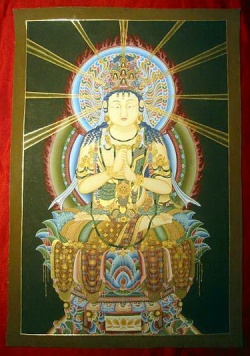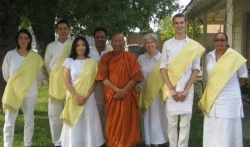Difference between revisions of "The Korean Buddhist Schools"
Jump to navigation
Jump to search
| Line 1: | Line 1: | ||
{{DisplayImages|3963|626|2861|3195|555}} | {{DisplayImages|3963|626|2861|3195|555}} | ||
| − | + | Five [[doctrinal]] schools: These are academically-oriented schools, labeled together under the rubric of [[kyo]] (meaning "{{Wiki|learning}}" or "study") | |
| − | Five doctrinal schools: These are academically-oriented schools, labeled together under the rubric of kyo (meaning "learning" or "study") | ||
| − | + | * [[Kyeyul]] (Skt. [[Vinaya]]) school: The school of the [[Silla]] was known in the [[Koryô]] as [[Namsang chong]]. Which focused on study and implementation of [[moral discipline]]. | |
| − | + | * [[Yôlban]] (Skt. [[Nirvaana]]) school: The school was termed [[Sihûng chong]]. Which was based in the themes of the [[Mahaaparinirvaana-sutra]] (it elucidates the premise that "[[all living beings]] possess innate [[Buddhahood]]"). | |
| − | + | * [[Pôpsông]] ("[[dharma-nature]]") school: Pôpsông was termed Chungdo chong , the [[Pôpsang]] was termed [[Chaûn chong]]. The Pôpsông's [[Wikipedia:Hermeneutics|hermeneutical]] methods were derived in great part from [[Hwôm]], [[Consciousness-only]] and [[Tathaagatagarbha]] [[doctrines]]. It was also the organizing [[principle]] of the influential Ta-sheng ch'i-hsin lun ([[Awakening]] of [[Mahaayaana]] [[Faith]]) and many other texts of {{Wiki|East Asian}} provenance. This usage of [[essence-function]] as a primary [[Wikipedia:Hermeneutics|hermeneutical]] [[principle]] by which to harmonize apparently antagonistic [[doctrinal]] stances became a hallmark of [[Korean]] [[Buddhist]] synthetic {{Wiki|discourse}}. | |
| − | + | * [[Wôllyung]] (Ch. [[Yüan-jung]]) school: The school was termed [[Hwaôm chong]]. Which focuses on the actualization of the [[metaphysics]] of interpenetration as found in the [[Hua-yen Sutra]]. This school, also known in [[Korea]] as [[Hwaôm]] (Ch. [[Hua-yen]]), is the most long-lived of the {{Wiki|Chinese}} imported schools. | |
| − | + | * [[Sôn]]: The school is a meditation-based [[view]] of practice which came to be known as [[Ch'an]] ({{Wiki|Chinese}}, meaning "[[meditation]]," widely known in the [[West]] through its [[Japanese]] variant [[Zen]]) | |
| − | |||
| − | |||
| − | |||
| − | |||
| − | |||
| − | |||
| − | |||
| − | |||
Other schools: | Other schools: | ||
| − | + | * [[Ch'ônt'ae]] (Ch. [[Tien-tai]]) school: In [[China]], [[Tien-tai]] is viewed as a [[doctrinal]] school, but in [[Korea]] [[Ch'ônt'ae]] is seen as a [[meditational]] school. The other [[meditational]] school is [[Sôn]]. | |
| − | + | * [[Samnon]] (Ch. [[San-lun]]) school: Which focused on the [[Indian]] [[Maadhyamika]] ([[Middle Path]]) [[doctrine]], and was initially popular in Koguryô and [[Wikipedia:Baekje|Paekche]]. | |
| − | + | * [[Yusik]] (Ch. [[Wei-shih]], "[[Consciousness-only]]") school: A late [[Indian]] [[Mahaayaana]] school that gave an extremely detailed and complex account of the [[makeup]] of the [[human]] [[Wikipedia:Psyche (psychology)|psyche]]. Most important of its teachings was that of the [[Storehouse]], or Base [[consciousness]], which served as the basis for [[transmigration]]. This school taught that all [[existences]] were none other than {{Wiki|projections}} of this base [[consciousness]]. The [[Mind-only]], and "permeation" aspects of [[Consciousness-only]] [[doctrine]] [[offered]] many affinities with Wônyung/Hwaôm (Ch. [[Hua-yen]]) [[thought]]. | |
| − | + | * Chungdo ("[[Pure Land]]") school: This school teaches relatively simple methods of {{Wiki|recitation}} of the [[name]] of the [[Buddha]] (yômbul, Ch. [[nien-fo]]) for the purpose of [[attaining]] [[rebirth]] in the {{Wiki|Western}} [[Heaven]] ([[Pure Land]]). Because this practice is so easy, it turned out to be the most popular [[form]] of [[Buddhism]] among the common [[people]] and lay practitioners. | |
| − | |||
| − | |||
| − | |||
| − | |||
| − | |||
| − | |||
| − | |||
| − | |||
| − | |||
| − | |||
| − | |||
| − | |||
| − | |||
| − | |||
| − | + | The {{Wiki|Modern}} [[Sôn School]] is comprised of : | |
| − | + | (1). [[Chosôn Sôn]] | |
| − | + | : [[Ch'ônt'ae]] (Ch. [[Tien-tai]]) | |
| + | : [[Chogye]] | ||
| − | + | (2). [[Kyo]] | |
| − | + | : [[Kyeyul]] | |
| + | : [[Pôpsang]] | ||
| + | : [[Shihûng]] (formerly [[Yôlban]]) | ||
| + | : [[Chungdo]] (or [[Chôngt'o[[) | ||
| + | : [[Hwaôm]] (formerly [[Wôllyung]]) | ||
| − | |||
| − | |||
{{R}} | {{R}} | ||
[http://www.manjushri.com/Teachings/1-TKorean.htm www.manjushri.com] | [http://www.manjushri.com/Teachings/1-TKorean.htm www.manjushri.com] | ||
[[Category:Korea]] | [[Category:Korea]] | ||
Latest revision as of 10:40, 22 April 2014
Five doctrinal schools: These are academically-oriented schools, labeled together under the rubric of kyo (meaning "learning" or "study")
- Kyeyul (Skt. Vinaya) school: The school of the Silla was known in the Koryô as Namsang chong. Which focused on study and implementation of moral discipline.
- Yôlban (Skt. Nirvaana) school: The school was termed Sihûng chong. Which was based in the themes of the Mahaaparinirvaana-sutra (it elucidates the premise that "all living beings possess innate Buddhahood").
- Pôpsông ("dharma-nature") school: Pôpsông was termed Chungdo chong , the Pôpsang was termed Chaûn chong. The Pôpsông's hermeneutical methods were derived in great part from Hwôm, Consciousness-only and Tathaagatagarbha doctrines. It was also the organizing principle of the influential Ta-sheng ch'i-hsin lun (Awakening of Mahaayaana Faith) and many other texts of East Asian provenance. This usage of essence-function as a primary hermeneutical principle by which to harmonize apparently antagonistic doctrinal stances became a hallmark of Korean Buddhist synthetic discourse.
- Wôllyung (Ch. Yüan-jung) school: The school was termed Hwaôm chong. Which focuses on the actualization of the metaphysics of interpenetration as found in the Hua-yen Sutra. This school, also known in Korea as Hwaôm (Ch. Hua-yen), is the most long-lived of the Chinese imported schools.
- Sôn: The school is a meditation-based view of practice which came to be known as Ch'an (Chinese, meaning "meditation," widely known in the West through its Japanese variant Zen)
Other schools:
- Ch'ônt'ae (Ch. Tien-tai) school: In China, Tien-tai is viewed as a doctrinal school, but in Korea Ch'ônt'ae is seen as a meditational school. The other meditational school is Sôn.
- Samnon (Ch. San-lun) school: Which focused on the Indian Maadhyamika (Middle Path) doctrine, and was initially popular in Koguryô and Paekche.
- Yusik (Ch. Wei-shih, "Consciousness-only") school: A late Indian Mahaayaana school that gave an extremely detailed and complex account of the makeup of the human psyche. Most important of its teachings was that of the Storehouse, or Base consciousness, which served as the basis for transmigration. This school taught that all existences were none other than projections of this base consciousness. The Mind-only, and "permeation" aspects of Consciousness-only doctrine offered many affinities with Wônyung/Hwaôm (Ch. Hua-yen) thought.
- Chungdo ("Pure Land") school: This school teaches relatively simple methods of recitation of the name of the Buddha (yômbul, Ch. nien-fo) for the purpose of attaining rebirth in the Western Heaven (Pure Land). Because this practice is so easy, it turned out to be the most popular form of Buddhism among the common people and lay practitioners.
The Modern Sôn School is comprised of :
(1). Chosôn Sôn
(2). Kyo




